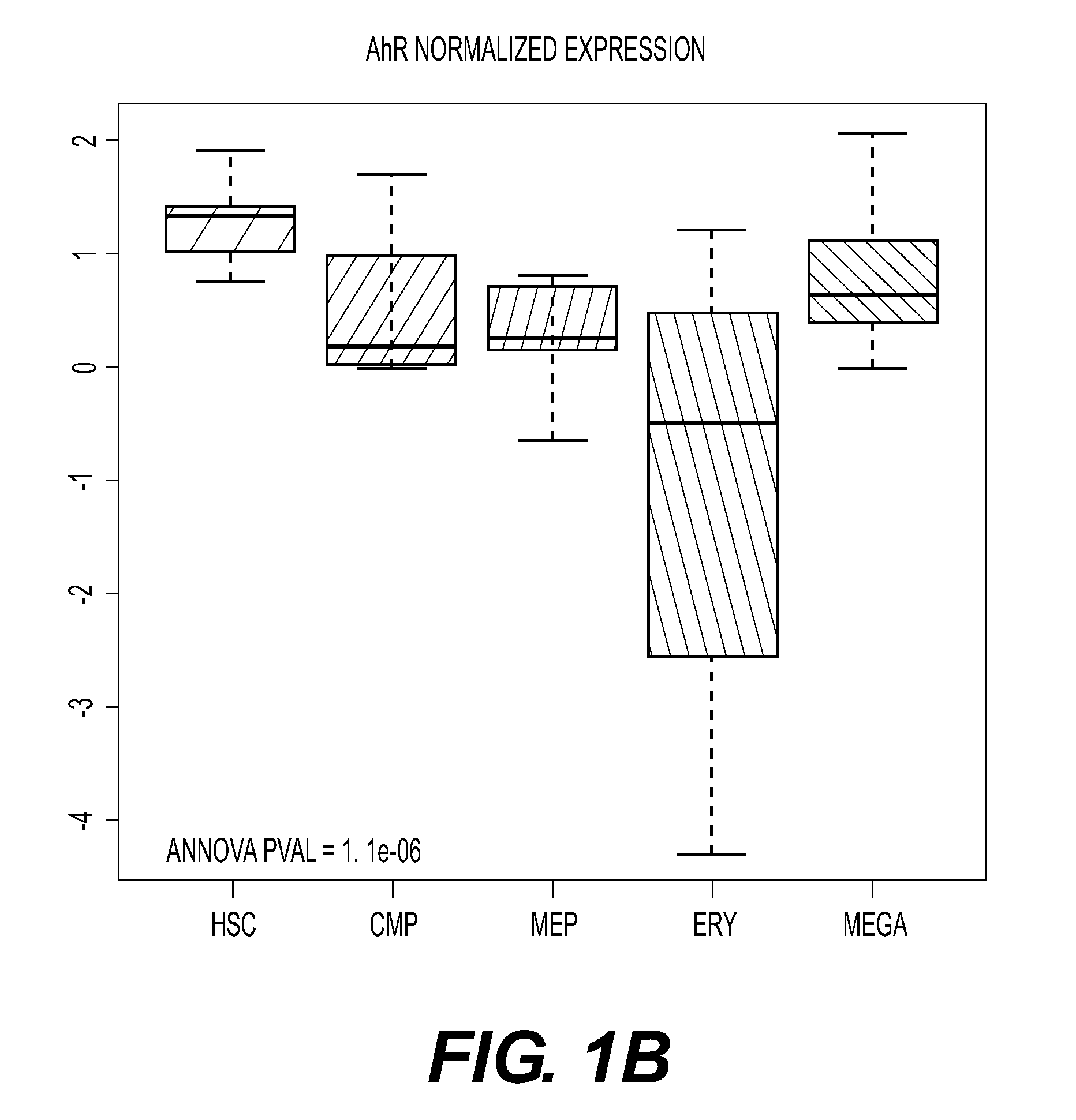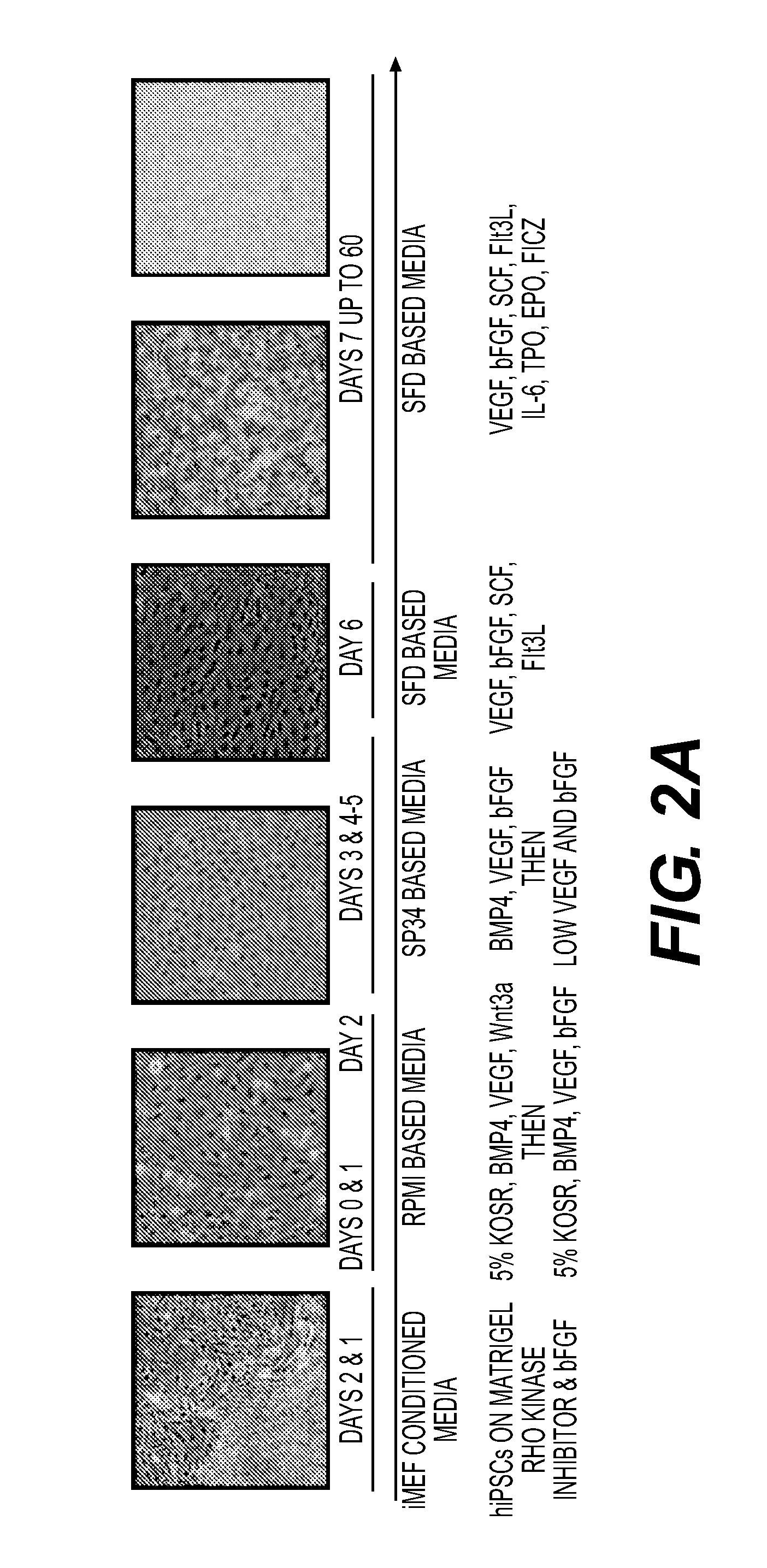Production of red blood cells and platelets from stem cells
a technology of stem cells and red blood cells, which is applied in the direction of instruments, drug compositions, extracellular fluid disorders, etc., can solve the problems of sporadic shortages of blood, blood supply may be curtailed by new restrictions on donor eligibility, and the patient group may have a chronic shortage of blood
- Summary
- Abstract
- Description
- Claims
- Application Information
AI Technical Summary
Benefits of technology
Problems solved by technology
Method used
Image
Examples
example 1
Analysis of Human Hematopoietic Cell Differentiation Genomic Mapping (dMap) Data
[0376]As a roadmap for assessing the possible role of the AhR receptor in hematopoietic cells, we analyzed the “dMap” dataset (www.broadinstitute.org / dmap) (Novershtern, N. et al. Densely interconnected transcriptional circuits control cell states in human hematopoiesis. Cell 144, 296-309 (2011)) a publicly available compendium of expression profiles from 71 distinct purified populations of human hematopoietic cells. For our purposes, we focused on the HSC-to-Mk / erythroid differentiation path, and we analyzed the expression of a manually curated list of putative AhR targets. Hierarchical clustering was carried out to evaluate the co-expression patterns of AhR and its targets. This analysis revealed up-regulated Ahr mRNA expression in primitive stem cells, from the HSC to the MEP cell stage (FIG. 1). Erythroid cells clustered into 2 groups of cells with either up- or down-regulated Ahr. Ahr levels were co...
example 2
Production of Megakaryocyte-Erythroid Progenitors (MEPs) from Induced Pluripotent Stem Cells (iPSCs)
[0377]This example demonstrates the feeder-free, chemically defined production of megakaryocyte-erythroid progenitors (MEPs) from induced pluripotent stem cells (iPSCs), and shows that the cells express definitive markers of both the megakaryocyte and erythroid lineages. We sought to develop a novel, feeder-free, chemically-defined system for the production of hematopoietic progenitor cells from human iPSCs that would not be beholden to the use of stromal cell lines or xenogeneic agents, and would result in the ability to produce large numbers of clinically relevant, high purity hematopoietic cells. The approach employed in the development of this platform follows the roadmap provided by the developing embryo. Since ESC and iPSC resemble pluripotent, undifferentiated cells of the early blastocyst embryo, the signals active in the early embryo were harnessed to direct the differentiati...
example 3
The Aryl Hydrocarbon Receptor (AhR) Agonist FICZ Allows for the Exponential Expansion of iPSC-Derived MEPs
[0378]Translation of iPSC technology to clinical applications has been hindered by the inability to produce sufficient, clinically relevant quantities of cells. Even for basic research studies, the numbers and quality of hematopoietic cells that can be produced through the directed differentiation of iPSC can be limiting (Chang, K. H., Bonig, H. & Papayannopoulou, T. Generation and characterization of erythroid cells from human embryonic stem cells and induced pluripotent stem cells: an overview. Stem Cells Int. 2011, 791604. Epub 792011 October 791626. (2011)). Here, we demonstrate that the AhR agonist FICZ has the ability to allow for the exponential expansion of iPSC-derived MEPs. In comparison to untreated control samples, FICZ-treated day 30 MEPs demonstrate significantly less cell death as judged by propidium iodide staining and Hoecsht dye exclusion allowing for the expon...
PUM
| Property | Measurement | Unit |
|---|---|---|
| diameter | aaaaa | aaaaa |
| diameter | aaaaa | aaaaa |
| time | aaaaa | aaaaa |
Abstract
Description
Claims
Application Information
 Login to View More
Login to View More - R&D
- Intellectual Property
- Life Sciences
- Materials
- Tech Scout
- Unparalleled Data Quality
- Higher Quality Content
- 60% Fewer Hallucinations
Browse by: Latest US Patents, China's latest patents, Technical Efficacy Thesaurus, Application Domain, Technology Topic, Popular Technical Reports.
© 2025 PatSnap. All rights reserved.Legal|Privacy policy|Modern Slavery Act Transparency Statement|Sitemap|About US| Contact US: help@patsnap.com



